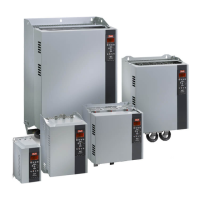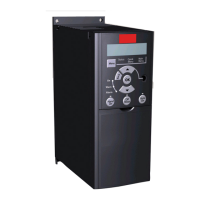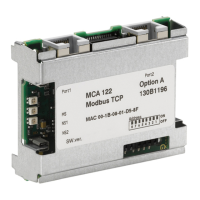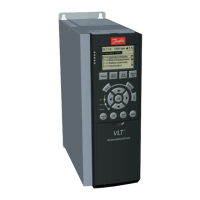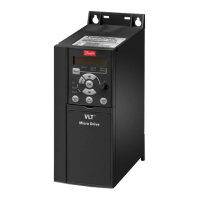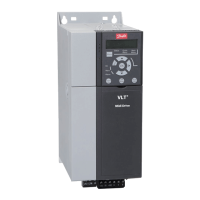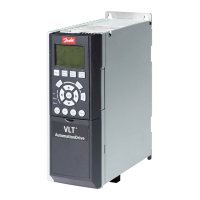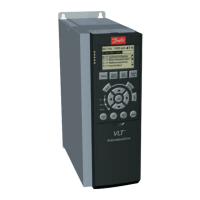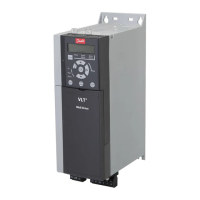WARNING/ALARM 26, Brake resistor power limit
The power transmitted to the brake resistor is calculated as
a mean value over the last 120 s of run time. The
calculation is based on the intermediate circuit voltage and
the brake resistance value set in parameter 2-16 AC Brake
Max. Current. The warning is active when the dissipated
braking energy is higher than 90% of the brake resistance
power. If [2] Trip is selected in parameter 2-13 Brake Power
Monitoring, the adjustable frequency drive trips when the
dissipated braking energy reaches 100%.
WARNING/ALARM 27, Brake chopper fault
The brake transistor is monitored during operation. If a
short circuit occurs, the brake function is disabled and a
warning is issued. The adjustable frequency drive is still
operational, but since the brake transistor has short-
circuited, substantial power is transmitted to the brake
resistor, even if it is inactive.
Remove power from the adjustable frequency drive and
remove the brake resistor.
This alarm/warning could also occur if the brake resistor
overheats. Terminals 104 and 106 are available as brake
resistor Klixon inputs, see Brake Resistor Temperature Switch
in the Design Guide.
WARNING/ALARM 28, Brake check failed
The brake resistor is not connected or not working.
Check parameter 2-15 Brake Check.
ALARM 29, Heatsink temp
The maximum temperature of the heatsink has been
exceeded. The temperature fault does not reset until the
temperature drops below a
dened heatsink temperature.
The trip and reset points are dierent based on the
adjustable frequency drive power size.
Troubleshooting
Check the following conditions:
•
Ambient temperature too high.
•
Motor cable too long.
•
Incorrect airow clearance above and below the
adjustable frequency drive.
•
Blocked airow around the adjustable frequency
drive.
•
Damaged heatsink fan.
•
Dirty heatsink.
For D, E and F enclosure sizes, this alarm is based on the
temperature measured by the heatsink sensor mounted
inside the IGBT modules. For F enclosures, the thermal
sensor in the rectier module can also cause this alarm.
Troubleshooting
•
Check fan resistance.
•
Check soft charge fuses.
•
IGBT thermal sensor.
ALARM 30, Motor phase U missing
Motor phase U between the adjustable frequency drive
and the motor is missing.
Troubleshooting
•
Remove power from the adjustable frequency
drive and check motor phase U.
ALARM 31, Motor phase V missing
Motor phase V between the adjustable frequency drive
and the motor is missing.
Troubleshooting
•
Remove power from the adjustable frequency
drive and check motor phase V.
ALARM 32, Motor phase W missing
Motor phase W between the adjustable frequency drive
and the motor is missing.
Troubleshooting
•
Remove power from the adjustable frequency
drive and check motor phase W.
ALARM 33, Inrush fault
Too many power-ups have occurred within a short time
period. Let the unit cool to operating temperature.
WARNING/ALARM 34, Serial communication bus
communication fault
The serial communication bus on the communication
option card is not working.
WARNING/ALARM 35, Out of frequency range
This warning is active if the output frequency has reached
the high limit (set in parameter 4-53 Warning Speed High)
or low limit (set in parameter 4-52 Warning Speed Low). In
[3] Closed-loop (parameter 1-00
Conguration Mode), this
warning is displayed.
WARNING/ALARM 36, Mains failure
This warning/alarm is only active if the supply voltage to
the adjustable frequency drive is lost and
parameter 14-10 Mains Failure is NOT set to [0] No Function.
Troubleshooting
•
Check the fuses to the adjustable frequency drive
and line power supply to the unit.
ALARM 38, Internal fault
When an internal fault occurs, a code number
dened in
Table 8.4 is displayed.
Troubleshooting
•
Cycle power.
•
Check that the option is properly installed.
•
Check for loose or missing wiring.
Contact the Danfoss supplier or Danfoss service, if
necessary. Note the code number for further trouble-
shooting directions.
Warnings and Alarms
Instruction Manual
MG11F522 Danfoss A/S © 08/2014 All rights reserved. 129
8 8
